tkd4life
Ultimate Member
Sierra is probably just putting disclaimers in there for liability reasons since shorter COL, in most cases means higher pressures. I know, having them touch the lands also results in higher pressure.
That's why, unless I am shooting lead bullets, I stay somewhere in between.
John
Agreed, it is definitely important to remember that these manuals are written as much by lawyers as they are by reloading specialists.






